Windows 7 Performance Guide
by Ryan Smith and Gary Key on October 26, 2009 12:00 AM EST- Posted in
- Systems
Laptop Performance
With the different power and performance characteristics of a laptop (not to mention the battery!) we’re going to break out our laptop results from the rest of our desktop data.
If you have seen our OS Mobility Explored article, where we compared laptop usage across Windows and Linux, then you should have a pretty good idea of what you’re about to see. The following is a selection of the most relevant data from that article, using Gateway’s very similar Intel and AMD power laptops: the NV5807u and NV5214u respectively.

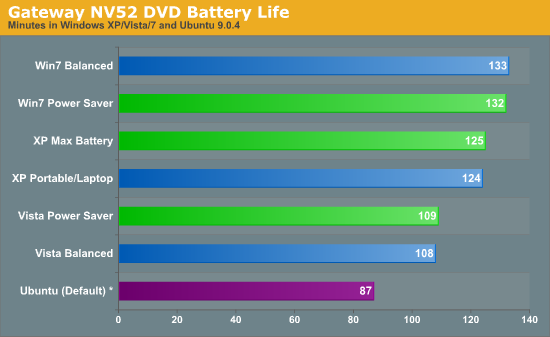

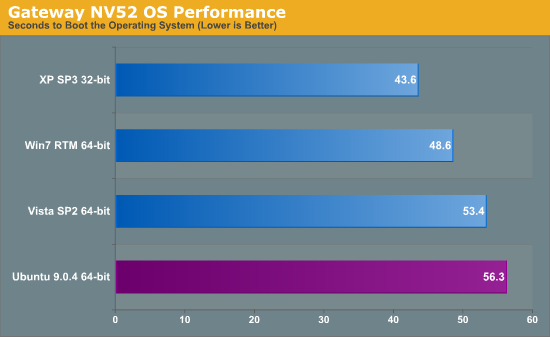
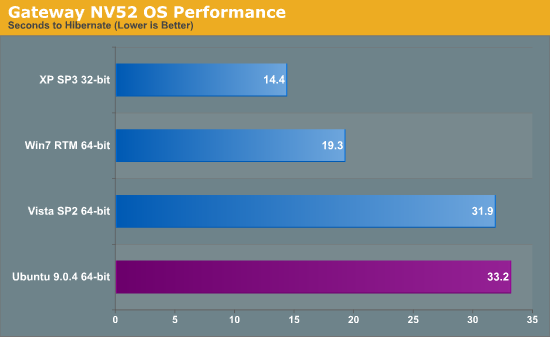
Starting with the NV52, our Athlon 64 X2 laptop, we see some immediate advantages for Windows 7. In terms of battery life it edges out Windows XP in all situations, and clearly surpasses Vista, particularly in DVD playback. As laptops have been one of Vista’s most troublesome areas, it’s here where Microsoft needed to see some real improvement, and they have delivered.
Meanwhile performance in our limited suite of benchmarks is largely tied. Vista wins in PCMark 05 only due to higher scores in the transparent windows test (something we suspect is a product of the WDDM 1.1 memory optimizations), XP takes 3DMark 03, and Win7 takes PCMark Vantage. Our tendency is to put more weight in to PCMark Vantage, since it’s quantifying the improved laptop performance that we’ve been experiencing, but aren’t necessarily seeing in other benchmarks.
Finally we have boot and hibernation times. Microsoft has been putting some effort in to bringing down the boot times of Vista, and it shows here, although XP is too tough to beat. Hibernation is a similar story – it’s easier to resume from hibernation when you have less stuff to load.
The NV52 paints what’s probably going to be the average picture for Windows 7 on laptops. It’s as fast (if not faster) than XP and can pull off a slightly better battery life, but it’s not going to be able to beat XP in booting/hibernating.
Next we have the NV58, our Intel C2D laptop.
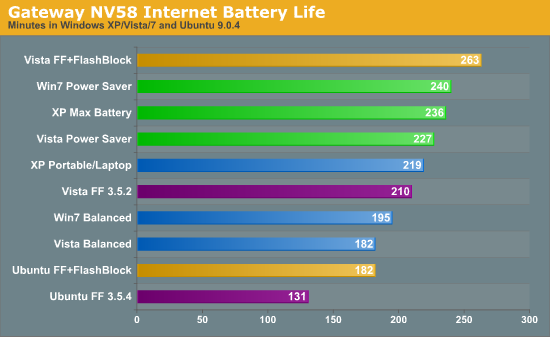
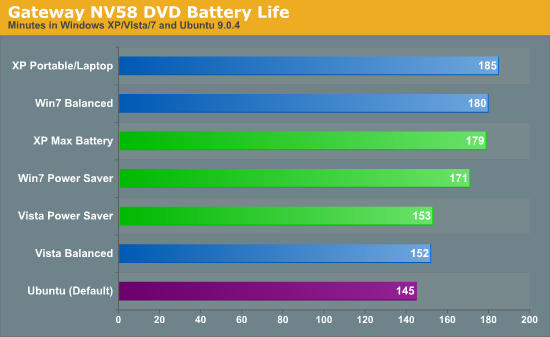
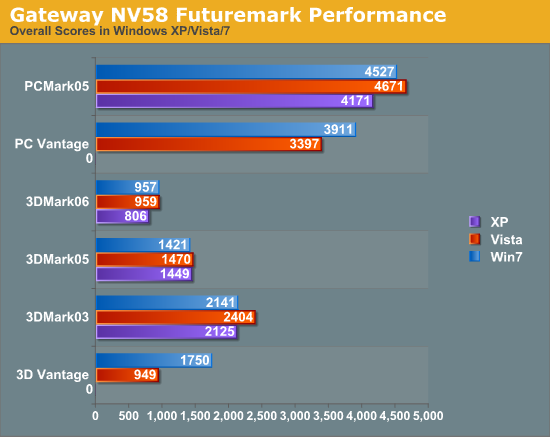
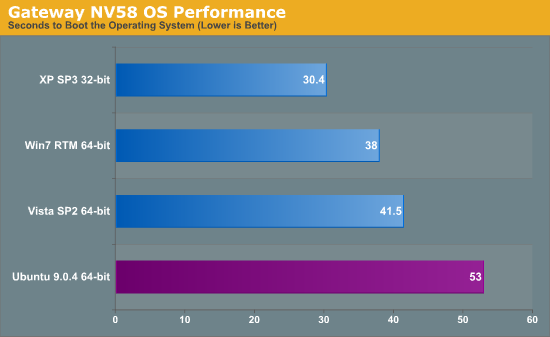

With battery life, we see some things similar to the AMD based NV52, and some things are different. Vista is still a loser, but Win7 doesn’t manage to build any kind of lead over XP in DVD playback, letting XP take it by a small margin. Battery life in our internet testing does go to Win7 however, once again with a small margin.
As for performance, we largely have the same results as with the NV52. Win7 wins PCMark Vantage, the test we care the most about, and pulls near-even elsewhere. 3DMark Vantage is an outlier this time, but this seems to be related to the Intel integrated graphics in this laptop.
Finally boot and hibernation times are similar to what we saw with the NV52. XP is still faster to boot and faster to return from hibernation, the benefit of an older, lighter-weight operating system. Win7 does handily beat Vista in all cases, however.










207 Comments
View All Comments
Genx87 - Wednesday, October 28, 2009 - link
It is Vista with a facelift. If you already have Vista i agree with you. I only have Win7 thanks to my Technet account. Doubt i would pay for the upgrade from Vista.But I still think Win7 is a very kickass OS. I have been impressed. Except for the dumbing down of UAC.
bigpow - Monday, October 26, 2009 - link
If you're just going over the features, and installation of Win7 - why call it performance guide?"Intro to Win7" would be more appropriate.
We expect to see performance related GUIDES, when we saw that title.
Not just some boring and obvious old-recycled presentations the whole internet has already gone through.
So boring!
computerfarmer - Monday, October 26, 2009 - link
Windows 7 was released and the people with AMD systems running RAID setups were in shock, no RAID drivers for windows 7. This is an issue. Today there has been RAID drives posted at the AMD site, with the posting date back dated to the 22nd.I had tried for hours try to get this new OS installed on the 23rd, but none of the available drivers were accepted by Win7. There for I could not install with a RAID setup. After Googling for a bit I realized I was not the only one, this was a far bigger problem.
My initial excitement of enjoying the weekend with the new OS did not take place. It is now monday and I am wondering when I will take another stab at another install attempt.
The link I have found for the AMD RAID driver is
http://game.amd.com/us-en/drivers_catalyst.aspx">http://game.amd.com/us-en/drivers_catalyst.aspx
Why was this issue not covered by any review sit?
Genx87 - Wednesday, October 28, 2009 - link
This is an AMD issue, not a Win7 issue????How is it Microsofts fault AMD dropped the ball with their RAID driver support?
DominionSeraph - Monday, October 26, 2009 - link
"Why was this issue not covered by any review sit?"Because it's not a Windows 7 issue.
computerfarmer - Monday, October 26, 2009 - link
I believe you are half right.If a business runs a raid setup and most do, they can not use this.
If individuals run raid, they can not use this.
If millions of businesses and individuals can not use this. Then what good is an operating system that so many can not use. This is not good business.
The RC version worked with the existing drivers and the RTM version came with out warning that the rules had changed for this OS. The OS has changed, therefor this is an OS issue.
Genx87 - Wednesday, October 28, 2009 - link
How many businesses do you know run RAID on their desktops? I'd like to know myself because in the thousands of workstations I have built over the past years only a handful ever used any form of RAID. And those were RAID 1 and I am convinced the engineers who ordered them only did it to say they have RAID.DominionSeraph - Monday, October 26, 2009 - link
"Certainly someone is going to bite my head off for this, but I don’t think Microsoft should have made such a fundamental change to UAC. More casual users may not have been fond of how Vista or UAC Level 3 handle security, but it was a more secure choice than Level 2."What are you doing complaining about security while running as admin?
UAC is about social engineering. That it acts like a security feature is because if you want to engineer towards the security model with limited accounts, you have to make the administrator account act like one.
The standard access tokens and UAC nags used by the administrator account are not a part of the tiered model's administrator level -- they're there to mimic the experience of a standard user account so programmers will actually program for standard user account access. (and so users will get used to the prompts for elevation that come with operating as a standard user.)
To obsess over a reduction in limited user -type security in the administrator account is to miss the point that that's not even aligned with Microsoft's security philosophy. Their model (along with everbody else) has been tiered privileges, not somehow patching all possible vulnerabilities out of root.
Vista's default UAC was pretty much universally reviled. People wanted fewer nags, meaning less limited-access -like behavior. But you can't have auto-elevation without a reduction in security.
Could Microsoft do a better job securing the hole they opened to god-mode from the administrator account? Yes. Would the amount of effort be insane, judged in light of the fact that an administrator account is supposed to be god mode? Yes.
Should Microsoft rewrite the Win7 kernel so that these apps run in protected space that restricts them to pre-authorized actions and disallows daughter processes just so the lazy and power-mad among us can dismiss the logical security scheme and continue to run as Administrators 24/7? There's always going to be system vulnerability from the administrator account -- that's kinda its purpose. Instead of trying to secure the unsecurable, Microsoft is trying to get people to embrace a better model.
And at least they took out the obvious stupidity, like MSPaint auto-elevating. (You can delete anything [like C:\WINDOWS] from its file manager when elevated.)
And, for the record, I'm one of those lazy and power-mad who run as Admin 24/7. But I'm also on a non-critical machine.
DominionSeraph - Monday, October 26, 2009 - link
http://technet.microsoft.com/en-us/magazine/2009.0...">http://technet.microsoft.com/en-us/maga.../2009.07...ElectricBlue7331 - Monday, October 26, 2009 - link
What's the big deal about out of the box codec support? Is it really that difficult to get a different media player and/or codec pack?